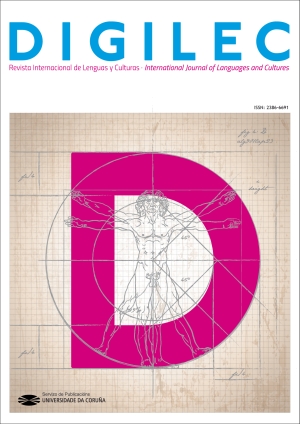Voices of silenced childhoods: Transience as decentering spatiality in three contemporary films
Main Article Content
Abstract
The interconnection between space production, place configuration, and identity development is interrogated in this essay through the lens of three film directors with transnational backgrounds. These auteurs introduce with Huelepega: La ley de la calle (Elia Schneider), Le temps du loup (Michael Haneke), and Children Underground (Edet Belzberg) the complications accrued by abandoned children and problem young adults whose erratic lives have forced them to dwell in transitional places. This essay looks at the spatial consequences of the confrontation of childhood and reterritorialization, and explores the ramifications of these interactions in terms of spatiality and place resignification.
Keywords:
Downloads
Article Details
References
Arndt, S. (2018). Early childhood teacher cultural otherness and belonging. Contemporary Issues in Early Childhood, 19 (4), 392-403.
Ashcroft, R. E. (2003). American Biofutures: Ideology and Utopia in the Fukuyama/Stock Debate. Journal of Med Ethics, 29, 59-62.
Augé, M. (2008). Non-places: Introduction to an Anthropology of Supermodernity. London: Verso.
Barros-Grela, E. and Bobadilla Pérez (2015). Space and Children in Post-Apocalyptic Film: The Road and Les temps du loup. In The Child in Post-Apocalyptic Cinema, D. Olson (ed.), 77-90. Lanham, MD: Lexington Books.
Belzberg, E. (Director). (2001). Children Underground [Film]. Belzberg Films.
Bolzan, N. & Gale F. (2012). Using an Interrupted Space to Explore Social Resilience with Marginalized Young People. Qualitative Social Work, 11 (5), 502-516. https://doi.org/10.1177/1473325011403959
Daly Bednarek, J. R. (2019). Place or Non-place: The Relationship between Cities and Their Airports. Journal of Urban History, 45 (2), 386-392.
Davis, M. (2003). Dead Cities and Other Tales. London and New York: Verso.
Davis, M. (2007a). Evil Paradises. Dreamworlds of Neoliberalism. London and New York: Verso.
Davis, M. (2007b). Planet of Slums. London and New York: Verso.
Deleuze, G. & Guattari, F. (2001). Pure Immanence: Essays on a Life. (Trans. J. Raichman). New York: Zone Books.
Deleuze, G. & Guattari, F. (2004a). A Thousand Plateaus: Capitalism and Schizophrenia. London and New York: Continuum International Publishing Group.
Deleuze, G. & Guattari, F. (2004b). The Logic of Sense. London and New York: Continuum International Publishing Group.
Fattore, T. (2016). Children’s Conceptions of Otherness: Constructions of the ‘Moral Self’ and Implications for Experiences of Migration. In Childhood, Youth and Migration, C. Hunner-Kreisel & S. Bohne (ed.), 49-62. Berlin: Springer.
Fukuyama, F. (1992). The End of History and the Last Man. New York: Basic.
Haneke, M. (Director). (2003). Le Temps du Loup. [Film]. Arte France Cinéma.
Kjeldgaard, D. & Askegaard, S. (2006). The glocalization of youth culture: The global youth segment as structures of common difference. Journal of Consumer Research, 33 (2), 231-247.
Lévèque, M. (2017). Les Childhood Studies in France: Esquisses d’un domaine à construire. Hypotheses.org, 9 Feb. https://magasindesenfants.hypotheses.org/5894
Malone K., Tesar, M. & Arndt, S. (2020). History and Philosophy of Children and Childhoods. In Theorising Posthuman Childhood Studies. Children: Global Posthumanist Perspectives and Materialist Theories, K. Malone, M. Tesar, & S. Arndt (eds.), 1-25. Berlin: Springer.
Nosál, I. (2009). Governing Abandoned Children: The Discursive Construction of Space in the Case of ‘Babybox’. In Discourse and Transformation in Central and Eastern Europe, A. Galasińska & M. Krzyżanowski (eds.), 114-136. Basingstoke: Palgrave Macmillan.
Oliver, K. (1998). Subjectivity Without Subjects: From Abject Fathers to Desiring Mothers. Lanham, Boulder, New York & Oxford: Rowman and Littlefield Publishers.
Preyer, G. & Bös, M. (2013). Borderlines in a Globalized World: New Perspectives in a Sociology of the World-System. Berlin: Springer.
Qvortrup, J. et al. (eds.). (2009). The Palgrave handbook of childhood studies. Basingstoke: Palgrave Macmillan.
Rumbaut, R. G. (1994). The Crucible within: Ethnic Identity, Self-Esteem, and Segmented Assimilation among Children of Immigrants. International Migration Review, 28 (4), 748-794.
Sack, R. (1986). Human Territoriality. Its Theory and History. Cambridge: Cambridge University Press.
Schneider, E. K. (Director). (1999). Huelepega. Ley de la calle. [Film]. Joel Films.
Soja, E. W. (1971) The Political Organization of Space, Washington: Association of American Geographers.
Waley, P. (1992). Fragments of a City: A Tokyo Anthology, Tokyo: The Japan Times.
Wall, J. (2019a). From childhood studies to childism: reconstructing the scholarly and social imaginations”. Children’s Geographies, 1-14. https://doi.org/10.1080/14733285.2019.1668912
Wall, J. (2019b). Theorizing children’s global citizenship: Reconstructionism and the politics of deep interdependence. Global Studies of Childhood, 9 (1), 5-17.
Woodhead, M. (2008). Childhood Studies: Past, Present and Future. In An Introduction to Childhood Studies, M. J. Kehily (ed.), 17-34. New York: McGraw-Hill Education.
Žižek, S. (2003). Organs without Bodies: Deleuze and Consequences. New York: Routledge.


